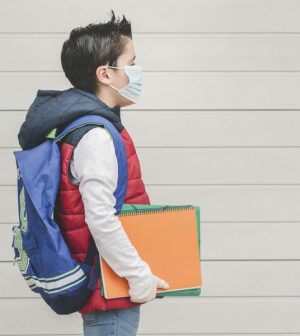- Skip Storing This Everyday Product in the Fridge Door
- Green Tea + B3 Pairing May Boost Brain Health
- Navigating Your Midlife Crisis: Embracing New Possibilities
- City Raccoons Showing Signs of Domestication
- Mapping the Exposome: Science Broadens Focus to Environmental Disease Triggers
- One Week Less on Social Media Linked to Better Mental Health
- Your Brain Changes in Stages as You Age, Study Finds
- Some Suicide Victims Show No Typical Warning Signs, Study Finds
- ByHeart Formula Faces Lawsuits After Babies Sickened With Botulism
- Switch to Vegan Diet Could Cut Your Greenhouse Gas Emissions in Half
Another Study Finds COVID Doesn’t Spread in Schools With Proper Safeguards

COVID-19 transmission is rare in schools that follow precautions such as mandatory masks, social distancing and frequent hand-washing, a new study finds.
And that’s true even among close school contacts of people who test positive for the new coronavirus, according to researchers at Washington University School of Medicine in St. Louis.
“Schools can operate safely during a pandemic when prevention strategies are followed,” said study co-leader Dr. Jason Newland, a professor of pediatrics.
His team conducted a pilot study that included 57 schools in St. Louis and Greene counties in southwest Missouri, as well as two private schools in St. Louis County. All required students, teachers, staff and visitors to wear masks while on campus or buses.
Other safety measures included hand hygiene, deep cleaning of facilities, physical distancing in classrooms, daily COVID-19 symptom screenings, physical barriers between teachers and students, increased ventilation and offering online learning options.
For two weeks in December, researchers were notified about students, teachers and staff who were either infected with COVID-19 or quarantined because they were in close contact with someone who had tested positive.
In all, the investigators were notified about 193 people at 22 schools (37 who tested positive for COVID-19 and 156 close contacts). A close contact is someone who has been within 6-feet of an infected person for more than 15 minutes in a 24-hour period.
Among study participants who were COVID-19-positive, 24 (65%) were students, and 13 (35%) were teachers or staffers. Of the close contacts, 137 (88%) were students, and 19 (12%) were teachers or staffers.
Of the 102 close contacts who agreed to saliva tests for COVID-19, only two had positive results, suggesting they were infected at school.
Despite high rates of community spread in December, there were no COVID-19 outbreaks in participating schools, according to the report published online March 19 in the U.S. Centers for Disease Control and Prevention’s Morbidity and Mortality Weekly Report.
The findings add to those from schools in other states showing that prevention efforts are highly effective at curbing the spread of COVID-19 among students, teachers and staff.
“The pilot study demonstrates low transmission in schools and no student-to-teacher transmission — and this was during the height of the pandemic in December, with high rates of community spread,” Newland noted in a university news release.
Senior study author Johanna Salzer is a veterinary medical officer at the CDC’s National Center for Emerging and Zoonotic Infectious Diseases.
She said, “This work is imperative because keeping kids in school provides not only educational enrichment but also social, psychological and emotional health benefits, particularly for students who rely on school-based services for nutritional, physical and mental health support.”
More information
The U.S. Centers for Disease Control and Prevention has more on COVID-19 and schools/child care.
SOURCE: Washington University School of Medicine, news release, March 19, 2021
Source: HealthDay
Copyright © 2025 HealthDay. All rights reserved.










